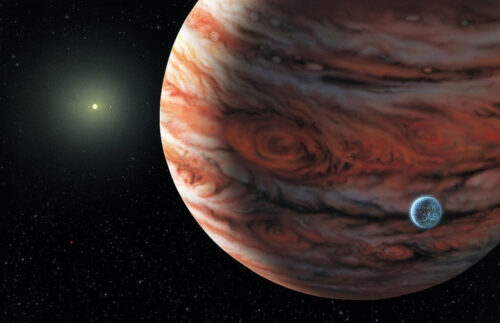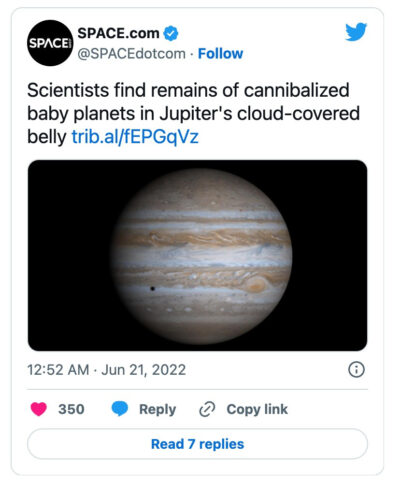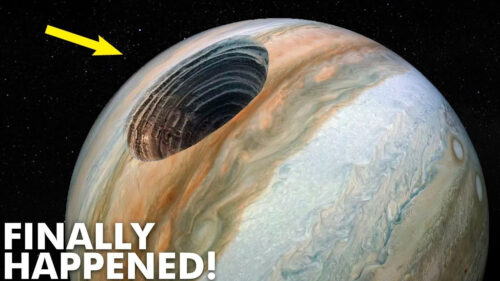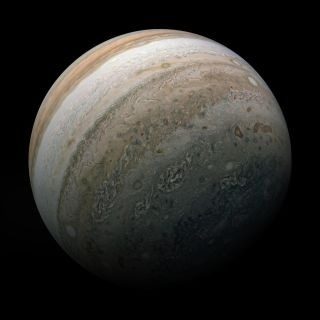
Scientists have made a remarkable finding on Jupiter, revealing that the gas giant’s interior is filled with remnants of baby planets that it swallowed during its expansion.
With the help of the Juno spacecraft and gravitational data, researchers gained unprecedented insight into the chemistry and composition beneath Jupiter’s cloudy exterior.
The study suggests that Jupiter devoured planetesimals to fuel its growth, shedding light on its mysterious formation.
These findings may also reshape our understanding of other gas giants in our solar system and beyond, emphasizing the need to explore them beyond their cloudy covers using advanced telescopes like NASA’s James Webb.
Jupiter, the Enigmatic Giant
Jupiter, the largest planet in our solar system, has long captivated astronomers with its awe-inspiring storms and swirling vortex clouds.

However, little was known about its inner workings until now. Scientists have been eager to uncover the secrets hidden beneath its cloudy facade, delving into its core and unraveling its origins.
Unveiling Jupiter’s Secrets
A recent study published in the Astronomy and Astrophysics journal marks a significant breakthrough in our understanding of Jupiter’s composition.
Led by Yamila Miguel, an astrophysicist at Leiden University, the research team used gravitational data collected by NASA’s Juno spacecraft to peer beneath the thick cloud cover.
The findings shed light on Jupiter’s rocky core, indicating a surprising abundance of heavy elements.
This chemical makeup suggests that Jupiter consumed baby planets or planetesimals during its formative years, providing the necessary material for its expansion.
Challenging Previous Assumptions
The study also challenges existing assumptions about the mixing of Jupiter’s atmosphere.
Scientists had previously believed that convection would cause the planet’s lower atmosphere to mix with the upper atmosphere, resulting in a more even distribution of heavy elements.
However, the new research indicates that the heavy elements have remained concentrated near the core and in the lower atmosphere, defying previous expectations.

An Influence on the Solar System
Jupiter’s role in shaping the solar system is crucial. Its immense gravitational pull has influenced the orbits and sizes of neighboring planets, exerting a significant impact on their formation.
The study suggests that Jupiter’s devouring of planetesimals might have played a pivotal role in determining the orbits and compositions of other gas giants in the solar system, including Uranus, Saturn, and Neptune.
Implications Beyond Our Solar System
The implications extend beyond our solar system, hinting at the potential origin of gaseous worlds in other star systems.

The findings suggest that these worlds may have also formed by gobbling up planetesimals, resulting in higher metallicity than their outward appearance suggests.
This discovery underscores the importance of searching for and studying these new worlds using advanced telescopes such as the upcoming James Webb Telescope by NASA.
Unlocking the Mysteries of Gas Giants
This breakthrough on Jupiter opens up a new chapter in our understanding of gas giants and their formation.
By delving beneath their cloudy covers, scientists can uncover the remnants of baby planets and unravel the mysteries of their origin.
The exploration of Jupiter serves as a stepping stone to unravel the secrets of gas giants both in our solar system and in distant star systems.
As we peer into the depths of these colossal worlds, we inch closer to comprehending the rich diversity of planetary systems in the universe.






